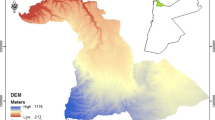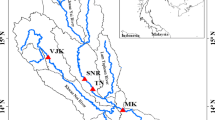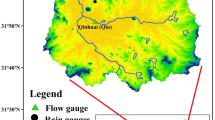Abstract
Drought index is an important tool for monitoring and evaluation. A new drought index for freshwater wetlands is developed based on water balance, then used to evaluate drought in Baiyangdian Wetland (BW). Choosing the high resolution data——daily water stage (if not available, choose monthly data alternatively) as input data to compute the Wetland Drought Index (WDI). The results may be presented in monthly, seasonal or annual scale, such as Standard Precipitation Index (SPI). Daily data was used in calculating WDI during 1960 to 1986, and the results are revealed in monthly, seasonal and annual time scale to compare with SPI and China Z Index (CZI). The results of WDI are in accordance with the local record of wetland drought (Anxin county annals, 2000), while the other indices are not. Daily data produce the most precise dating of droughts, but these data were not available after 1986, therefore monthly data were used. For the period before 1986, comparisons using monthly data and daily data identify the same droughts, and show only minor differences in resolving drought onset and termination dates. During 1960 to 2008, the frequency of drought was increasing, mainly because of the low precipitation and controlling of reservoirs upstream. There are five mainly drought periods identified by WDI during this time: 1965 ~ 1967, 1972 ~ 1973, 1975 ~ 1976, 1980 ~ 1986 and 2000 ~ 2008, which are not identified by SPI and CZI.







Similar content being viewed by others
References
Aherne J, Larssen T, Cosby BJ, Dillon PJ (2006) Climate variability and forecasting surface water recovery from acidification: Modelling drought-induced sulphate release from wetlands. The Science of the Total Environment 365:186–199
Boudreau LD, Rouse WR (1995) The role of individual terrain units in the water balance of wetland tundra. Climate Research 5:31–47
Boulton AJ (2003) Parallels and contrasts in the effects of drought on stream macroinvertebrate assemblages. Freshwater Biology 48:1173–1185
Burkett VR, Kusler J (2000) Climate Change: Potential impacts and interactions in wetlands of the United States. Journal of the American Water Resources Association 36:313–320
Compilation Committee of Local Chronicles of Anxin County (2000) Anxin county annals. Xinhua Publishing House, Beijing
Cui BS, Yang ZF (2006) Wetlands. Beijing Normal University Press, Beijing
Dahm CN, Baker MA, Moore DI, Thibault JR (2003) Coupled biogeochemical and hydrological responses of streams and rivers to drought. Freshwater Biology 48:1219–1231
Dong N (2009) Analysis of ecological drought and supplementing water to Baiyangdian Wetland from two reservoirs linking system. Dissertation, Agriculture University of Hebei
Dracup JA, Lee KS, Paulson EG (1980) On the definition of droughts. Water Resourc Res 16:297–302
Driver PD, Barbour EJ, Michener K (2011) An integrated surface water, groundwater and wetland plant model of drought response and recovery for environmental water management. 19th International Congress on Modelling and Simulation, Perth, Australia, 12–16
Euliss NH (2004) The Wetland Continuum: A Conceptual Framework for Interpreting Biological Studies. Wetlands 24(2):448–458
Kendall M, Stuart A (1977) The Advanced Theory of Statistics. Macmillan, New York
Keyantash J, Dracup JA (2002) The Quantification of Drought: An Evaluation of Drought Indices. Bulletin of the American Meteorological Society 83:1167–1180
Kim SY, Lee SH, Freeman C, Fenner N, Kang H (2008) Comparative analysis of soil microbial communities and their responses to the short-term drought in bog, fen, and riparian wetlands. Soil Biology and Biochemistry 40:2874–2880
Lake PS (2003) Ecological effects of perturbation by drought in flowing waters. Freshwater Biology 48:1161–1172
Li B, Liu CQ, Wang JX et al (2009) Carbon storage and fixation function by phragmites australis, a typical vegetation in Baiyangdian Lake. J of Agri-Environment Sc 28(12):2603–2607
Li YH, Cui BS, Yang ZF (2004) Influence of hydrological characteristic change of Baiyangdian on the ecological environment in wetland. J Nat Resourc 19(1):62–68
Liu CL, Xie GD, Xiao Y (2007) Impact of climate change on Baiyangdian wetland. Resourc Environ Yangtze Basin 16(2):245–250
Luo WB, Song FB, Xie YH (2008) Trade-off between tolerance to drought and tolerance to flooding in three wetland plants. Wetl 28(3):866–874
Matthews WJ, Marsh- Matthews E (2003) Effects of drought on fish across axes of space, time and ecological complexity. Freshwater Biology 48:1232–1253
Maybank J, Bonsal B, Jones K, Lawford R, O’Brien EG, Ripley EA, Wheaton E. (1995) Drought as a natural disaster. Atmosphere–ocean 33: 195–222
McKee TBN, Doesken J, Kleist J (1993) The relationship of drought frequency and duration to time scales, Eight Conf. On Applied Climatology, Anaheim, CA, Amer. Meteor. Soc. 179–184
Mitsch JW, Gosselink JG (2000) Wetlands. Wiley, New York
Moore PD (2001) Wetland. Facts on File Ine, New York
Mulhouse JM, Steven DD, Lidec RF, Sharitzd RR (2005) Effects of dominant species on vegetation change in Carolina bay wetlands following a multi-year drought. The Journal of the Torrey Botanical Society 132(3):411–420
Palmer WC (1965) Meteorological drought. Weather Bur Res Pap 45:58
Palmer WC (1968) Keeping track of crop moisture conditions, nationwide: The new Crop Moisture Index. Weatherwise 21:156–161
Phillips ID, McGregor GR (1998) The utility of a drought index for assessing the drought hazard in Devon and Cornwall, South West England. Meteorological Applications 5:359–372
Rasmussen EM, Dickinson RE, Kutzbach JE, Cleaveland MK (1993) Handbook of Hydrology. In: Maidment DR (ed) Climatology. McGraw-Hill, New York, pp 2.1–2.44
Rawls WJ, Ahuja LR, Brakensiek DL, Shirmohammadi A (1993) Handbook of Hydrology. In: Maidment DR (ed) Infiltration and soil water movement. McGraw-Hill, New York, pp 5.1–5.51
Richard R, Heim JR (2002) A Review of Twentieth-Century Drought Indices Used in the United States. American Meteorological Society 1149–1165
Shafer BA, and Dezman LE (1982) Development of a Surface Water Supply Index (SWSI) to assess the severity of drought conditions in snowpack runoff areas. Proc. 50th Western Snow Conf., Reno, NV, 164–175
Vicente-Serrano SM, L´opez-Moreno JI (2005) Hydrological response to different time scales of climatological drought: an evaluation of the Standardized Precipitation Index in a mountainous Mediterranean basin. Hydrology and Earth System Sciences 9:523–533
Wang Q, Yan DH, Qin TL, Yuan Y (2013) Impacts of Human Activities on Drought of Baiyangdian Lake. Wetland Science 11(4):475–481
Wihite DA, Hayes MJ, Knutson C, Smith KH (2000) Planning for drought: Moving from crisis to risk management. Journal of the American Water Resources Association 36:697–710
Wilhite DA, Buchanan-Smith M (2005) Drought as hazard: understanding the natural and social context. In: Wilhite DA (ed) Drought and Water Crises: Science, Technology, and Management Issues. CRC Press, Taylor & Francis Group, Florida, pp 3–29
Wu H et al (2001) An evaluation of the Standardized Precipitation Index, the China-Z Index and the statistical Z-Score. International Journal of Climatology 21(6):745–758
Ying F, Gonzalo MM (2011) A simple hydrologic framework for simulating wetlands in climate and earth system models. Climate Dynamic 37:253–278
Yuan WP, Zhou GS (2004) Comparison between standardized precipitation index and Z-index in China. Acta Phytoecologica Sinica 28(4):523–529
Zhao X, Cui BS, Yang ZF (2005) A study of the lowest ecological water stage of Baiyangdian Lake. Acta Ecologica Sinica 25(5):1033–1040
Zhao ZX (2012) Coupling Mechanism of Eco-hydrological Processes and integrated regulation in Baiyangdian Wetland. Doctoral dissertation of Tianjin University
Zhuang CW, Ouyang ZY, Xu WH et al (2011) Impacts of human activities on the hydrology of Baiyangdian Lake, China. Environmental Earth Sciences 62(7):1343–1350
Acknowledgments
This work was supported by National Basic Research Program of China “Influence Mechanism and Water Resources Security Evaluation of the Water Cycle of Huanghuaihai Region under the Impact of Climate Change” (Grant No.:2010CB951102); the General Program of the National Natural Science Foundation of China (Grant No. 51279207). We thank State Key Laboratory of Simulation and Regulation of Water Cycle in River Basin, China Institute of Water Resources and Hydropower Research. We thank Song WZ for helping borrowing Annual Hydrological Report P. R. China of Daqinghe River System, Haihe Basin and counting the drought period through wetland drought index (WDI) and Yang ZY for reviewing this paper and offering advices. Thank Zhang CW and Fan HY for examining the English expressions of this paper. At last, thank Yin J, Feng J and Gao XR for the help in revising this paper.
Author information
Authors and Affiliations
Corresponding author
Rights and permissions
About this article
Cite this article
Wang, Q., Yan, D.H., Yuan, Y. et al. Study on the Quantification of Drought in Freshwater Wetlands——A Case Study in Baiyangdian Wetland. Wetlands 34, 1013–1025 (2014). https://doi.org/10.1007/s13157-014-0565-7
Received:
Accepted:
Published:
Issue Date:
DOI: https://doi.org/10.1007/s13157-014-0565-7




